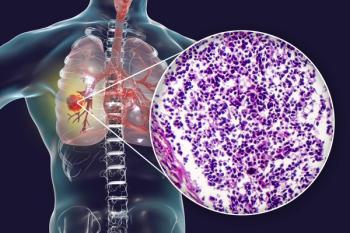
- ONCOLOGY Vol 39, Issue 5
- Volume 39
- Issue 5
- Pages: 180-182
The Role of Artificial Intelligence in Enhancing Precision Medicine for NSCLC
AI transforms non-small cell lung cancer management, enhancing diagnostics, treatment predictions, and personalized care strategies for improved patient outcomes.
Introduction
Non–small cell lung cancer (NSCLC) is the most common type of lung cancer worldwide and remains a leading cause of cancer-related mortality, necessitating innovative approaches to improve patient outcomes.1 Artificial intelligence (AI) has emerged as a transformative tool in precision medicine, offering advancements in diagnosis, treatment, and management. AI-driven diagnostic tools, such as machine learning algorithms and deep learning models, while still developing, can provide clinicians with more accessible and accurate data than ever before. Novel AI models are making strides in determining tumor genetics, predicting clinical response to treatment, and guiding clinicians’ management in real time. As AI improves, adopting these models will lead to a more personalized and timely care plan for all patients.
AI-Driven Diagnostic Tools
Imaging Analysis
AI is helping to enhance imaging modalities such as low-dose CT scans, PET-CT, and chest radiographs. Deep learning models analyze large imaging data sets with high precision, identifying subtle patterns often missed by human observers, leading to significantly increased accuracy. AI systems are also showing promise in differentiating between benign and malignant lesions, and even using radiographic features to predict genetic mutations. In a study by Tan et al, AI models predicted EGFR mutations and ALK rearrangement status with areas under the curve (AUCs) of 0.897 and 0.995, respectively, in the training cohort, showcasing the potential of AI in precise genetic profiling from imaging data.2 Additionally, Wang et al developed a multitask AI system that achieved AUCs of 0.842 for EGFR mutation status and 0.799 for PD-L1 expression status using CT images.3 As these models continue to improve, patients may not require pathologic diagnosis prior to treatment and can start therapy sooner, leading to fewer delays in care.
Histopathologic Diagnosis
AI tools are even aiding physicians at the histologic level by improving NSCLC subtype classification and genetic mutation profiling through digital whole slide imaging. Coudray et al demonstrated that a neural network could classify lung adenocarcinoma and squamous cell carcinoma with an average AUC of 0.97, comparable with pathologists’ performance.4 Furthermore, AI models can predict specific genetic mutations directly from histopathologic slides. For example, the same study found that AI could predict mutations in genes such as EGFR and KRAS with AUCs ranging from 0.733 to 0.856.
Predictive Modeling for Treatment Response
Treatment Response Prediction
While there are currently robust data modeling survival of patients with NSCLC, AI provides the opportunity to give individualized prognostic data based on personalized data such as the radiographic features of a patient’s specific CT. For example, Peng et al constructed a deep learning model to predict a patient’s response to chemotherapy and radiation (CCRT), ultimately demonstrating an AUC of 0.86 in the training cohort and 0.84 in the validation cohort, demonstrating strong predictive performance for CCRT response.7 The promise of future models trained on more comprehensive data could provide patients with more knowledge and ownership regarding their care plans if they could know their odds of treatment response.
Prognostic Assessments
Beyond treatment response, AI tools are advancing survival predictions for patients. Koyama et al developed an AI-based personalized survival prediction model using clinical and radiomics features, which accurately predicted survival outcomes in patients with advanced NSCLC.8 The model identified significant factors such as age, sex, performance status, and tumor PD-L1 expression, and was able to create one of the most accurate models to assess survival after diagnosis.
Kim et al created a deep learning model to predict recurrence risk in lung adenocarcinoma based on histopathological features.9 The model achieved an AUC score of 0.763 for predicting recurrence, with high-risk cases significantly associated with shorter recurrence-free survival and higher stages. The model identified specific histopathological features and genetic mutations, such as TP53, that were more frequent in high-risk groups, aiding in the identification of patients who may benefit from more aggressive adjuvant treatments.
Kinoshita et al developed an AI prognostic model for surgically resected NSCLC in 1049 patients.10 The model used 17 clinicopathological factors and 52 blood test results to predict disease-free survival (DFS), overall survival (OS), and cancer-specific survival (CSS). The AI model showed high predictive accuracy with AUC of 0.890 for DFS, 0.926 for OS, and 0.960 for CSS at 5 years, indicating its effectiveness in predicting postoperative prognosis and recurrence.
Ultimately, these AI models could represent a paradigm shift away from attempting to extrapolate survival data from preexisting survival curves to giving patients a more meaningful estimation of their mortality based on novel AI algorithms.
Clinical Decision Support Systems
Real-Time Guidance
Surgical care is being revolutionized with new AI interventions that enhance the safety and efficacy of surgical resection. New AI-powered systems can assist radiation oncologists and surgeons by providing real-time imaging analysis and predictive analytics.
AI-powered systems assist radiation oncologists with real-time imaging analysis and predictive analytics. For example, the Adaptive Radiotherapy Clinical Decision Support (ARCliDS) system optimizes radiotherapy dosages based on patient-specific data. ARCliDS estimates treatment outcomes for selected daily dosage values and reinforcement learning to recommend optimal daily dosage adjustments. This system demonstrated improved modeling performance and accurate dosage recommendations, enhancing tumor control and minimizing adverse effects.
During surgery, AI can analyze intraoperative imaging to guide resection margins and identify critical structures. Varghese et al discussed how AI integrated with near-infrared imaging can distinguish among normal, benign, and malignant tissues in real time, aiding surgeons in achieving precise resection margins and reducing complications.11 Additionally, Boland et al highlighted AI-enhanced indocyanine green perfusion analysis, which guides dissection planes and ensures complete tumor removal while preserving critical structures.12
Postoperatively, AI monitors patient data to predict potential complications and guide follow-up care. Ren et al demonstrated that the MySurgeryRisk AI system, using electronic health record data, could predict postoperative complications with high accuracy, achieving area under the receiver operating characteristic curve values of 0.82 for acute kidney injury and 0.87 for neurological complications. This predictive capability allows for timely interventions and personalized follow-up care.
Challenges and Future Directions
Despite AI’s potential, challenges such as data quality, model interpretability, and ethical considerations remain. AI models require high-quality, well-annotated data sets for accuracy and generalizability. Transparency issues limit clinician trust in AI-generated recommendations. Additionally, ethical concerns, including algorithmic bias and data security, necessitate stringent regulatory oversight. While AI demonstrates significant promise in this field, it remains important to recognize that AI tools will likely serve as adjunctive clinical tools that will likely enhance the efficacy of physicians such as radiologists and pathologists at providing clinical recommendations. Ultimately, the promise of AI will be unlocked by physicians translating the data to each unique clinical context.
Conclusion
AI significantly enhances precision medicine in NSCLC, improving diagnostic accuracy, treatment prediction, and personalized therapeutic strategies. AI-driven genetic profiling, radiomics, and clinical decision support systems have the potential to revolutionize patient care. However, addressing data quality, interpretability, and ethical challenges remains crucial. Future advancements in AI research and collaboration between clinicians and data scientists will be key to fully leveraging AI’s potential in NSCLC management.
References
- Hendriks LEL, Remon J, Faivre-Finn C, et al. Non-small-cell lung cancer. Nat Rev Dis Primers. 2024;10(1):71. Published 2024 Sep 26. doi:10.1038/s41572-024-00551-9. Published correction appears in Nat Rev Dis Primers. 2025 Jan 7;11(1):3. doi: 10.1038/s41572-025-00592-8
- Tan X, Li Y, Wang S, et al. Predicting EGFR mutation, ALK rearrangement, and uncommon EGFR mutation in NSCLC patients by driverless artificial intelligence: a cohort study. Respir Res. 2022;23(1):132.doi:10.1186/s12931-022-02053-2
- Wang C, Ma J, Shao J, et al. Predicting EGFR and PD-L1 Status in NSCLC Patients Using Multitask AI System Based on CT Images. Front Immunol. 2022;13:813072. doi:10.3389/fimmu.2022.813072
- Coudray N, Ocampo PS, Sakellaropoulos T, et al. Classification and mutation prediction from non-small cell lung cancer histopathology images using deep learning. Nat Med. 2018;24(10):1559-1567. doi:10.1038/s41591-018-0177-5
- Wu J, Liu C, Liu X, et al. Artificial intelligence-assisted system for precision diagnosis of PD-L1 expression in non-small cell lung cancer. Mod Pathol. 2022;35(3):403-411. doi:10.1038/s41379-021-00904-9
- Choi S, Cho SI, Ma M, et al. Artificial intelligence-powered programmed death ligand 1 analyser reduces interobserver variation in tumour proportion score for non-small cell lung cancer with better prediction of immunotherapy response. Eur J Cancer. 2022;170:17-26. doi:10.1016/j.ejca.2022.04.011
- Peng J, Zhang X, Hu Y, et al. Deep learning to estimate response of concurrent chemoradiotherapy in non-small-cell lung carcinoma. J Transl Med. 2024;22(1):896. Published 2024 Oct 4. doi:10.1186/s12967-024-05708-4
- Koyama J, Morise M, Furukawa T, et al. Artificial intelligence-based personalized survival prediction using clinical and radiomics features in patients with advanced non-small cell lung cancer. BMC Cancer. 2024;24(1):1417. Published 2024 Nov 18. doi:10.1186/s12885-024-13190-w
- Kim PJ, Hwang HS, Choi G, et al. A new model using deep learning to predict recurrence after surgical resection of lung adenocarcinoma. Sci Rep. 2024;14(1):6366. Published 2024 Mar 16. doi:10.1038/s41598-024-56867-9
- Kinoshita F, Takenaka T, Yamashita T, et al. Development of artificial intelligence prognostic model for surgically resected non-small cell lung cancer. Sci Rep. 2023;13(1):15683. doi:10.1038/s41598-023-42964-8
- Varghese C, Harrison EM, O'Grady G, Topol EJ. Artificial intelligence in surgery. Nat Med. 2024;30(5):1257-1268. doi:10.1038/s41591-024-02970-3
- Boland PA, Hardy NP, Moynihan A, et al. Intraoperative near infrared functional imaging of rectal cancer using artificial intelligence methods - now and near future state of the art. Eur J Nucl Med Mol Imaging. 2024;51(10):3135-3148. doi:10.1007/s00259-024-06731-9
Articles in this issue
6 months ago
Maximizing Safe Resection in High-Grade GliomasNewsletter
Stay up to date on recent advances in the multidisciplinary approach to cancer.



















































































